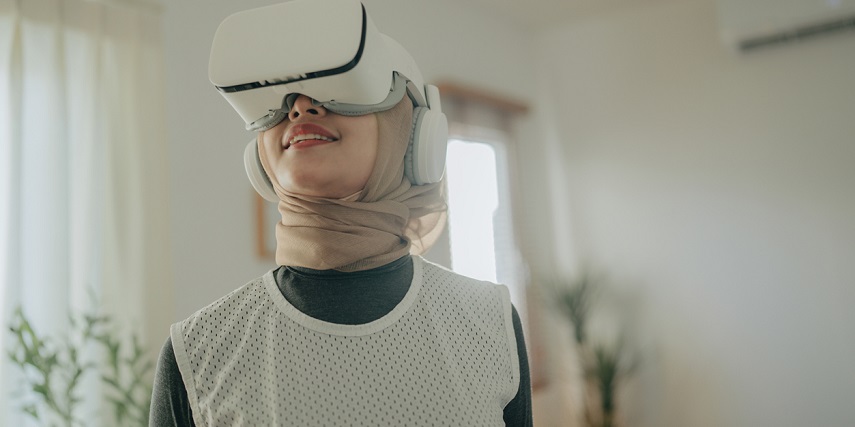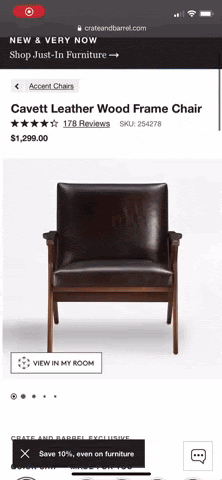The Differences Between AR and VR eCommerce Tools for B2C Sales

You may have already heard about companies using augmented reality in eCommerce. Both AR and VR eCommerce technologies are being used more than ever for brand awareness in eCommerce businesses with amazing results.
Do you want to give your customers immersive experiences, including gratifying, fast, and fun shopping? Any eCommerce CEO would say yes to this. But throwing something unique into the mix like AR and VR eCommerce tools can make you an industry leader.
Using a product configurator from Threekit utilizes 3D and AR technologies while cutting your costs, improving customer experiences, gathering data, and boosting your company's profitability.
Take a look at the differences between AR and VR eCommerce applications for your next B2C sales campaign.
The Use of Augmented Reality in eCommerce
You can define augmented reality as taking reality and adding digital graphics or digitally-created real-world items into that reality space. In other words, you can take a photo of your living room.
Then you can superimpose virtual household products (like furniture) into the spot where you plan to use them. Alternatively, you can use digital representations of products and view them through your smartphone as if they’re floating right in front of you.
This gives shoppers a new way to shop by seeing what a product looks like before they buy it. AR is certainly not new, but it may be new to your business’s niche. When it first became implemented in 1968, it was far more primitive-looking than what it turned into years later.
It wasn’t until 2008 that eCommerce companies used AR for commercial applications. Then in 2016, it took a flying leap forward into how businesses use it today. Everyone remembers when Pokémon GO became a cultural phenomenon in using AR on smartphones.
Nowadays, it's more sophisticated than ever and looks more real. A product configurator can help you achieve the use of augmented reality in eCommerce by creating the product images your customers want to see in reality.
The Use of Virtual Reality in eCommerce
Even virtual reality's origins go back to the 1960s with overly basic uses of creating virtual, digital realms. VR experiences didn't fully bloom until the 1990s. The big breakthrough came via VR headsets like Oculus during the 2010s.
Over the last few years, VR uses in eCommerce for virtual showrooms and virtual experiences have begun in earnest. Virtual reality takes you into a fabricated world where you can see what certain items look like in real time through a created environment.
In many cases, this also means recreating real environments in a digital way, then turning them into 3D configurations. A 3D product configurator is what makes this work well for the eCommerce industry.
VR helps bring online shopping experience innovations to a retailer like you. But it also helps people shop in a more escapist way.
What Are the Differences Between AR and VR eCommerce Use Cases?
The biggest difference between AR and VR eCommerce applications is this: AR uses a partial real-world setting, and VR is entirely artificial. Sometimes this overlaps in online retail, depending on how you want to feature your products.
For instance, creating a 3D configuration of your products is often like creating a virtual reality world. When the creations are superimposed over the representation of a real setting, it becomes AR.
Using either one as part of your new B2C visual economy is still an innovative way to help customers who prefer shopping online. During the COVID-19 pandemic, especially, using new technologies to create a shopping experience that seems like real life is why AR and VR are so valued, albeit sometimes used differently.
Three other differences exist between AR and VR when used in eCommerce. Let's take a deeper dive into what those are:
1. AR Helps Customers Control Their World, and VR Is Controlled by the System
Another noticeable difference in how AR and VR get used is in how users control them. AR experiences are unique in that the user controls where they want to place a particular product within the real world. It's a very versatile technology with no restrictions on where one places a household item in the picture of a room.
Virtual reality is usually controlled by the program itself. This isn't always the case when used in an eCommerce scenario. However, most VR programs give an experience to the user without the user having to control everything.
In most cases, a product configurator gives the shopper more freedom to formulate what they want to see. These shoppers can essentially build a particular product based on your business submitting photos of your product inventory. We can design 3D versions of your products at Threekit using virtual photography and a 3D configurator.
Virtual photography is one of the techniques we use, which helps you employ elements of VR without anyone having to use a headset.
Click here to learn more about how you can bring AR into your eCommerce store.
2. Users Access VR on Headsets and AR on Smartphones
Most interactive virtual reality setups require a customer to try on a headset to bring the full effect. Oculus is a good example of this, and many VR programs still utilize the same bulky technology. Headsets are cumbersome, and not many are willing to shop in an eCommerce store using one.
AR, on the other hand, is entirely used on a mobile device, just like it was when Pokémon GO was all the rage. Shoppers can place custom items in their living room, their office, or anywhere else to make sure the product fits their needs.
Matching AR with a custom product configurator allows shoppers to enjoy both technologies on smartphones or desktops. The increased engagement ultimately improves conversion rates.
3. AR Enhances the Real World While VR Creates a New Reality

Perhaps the widest difference between AR and VR eCommerce options is that AR helps enhance a real-world setting, often someone's room or a business area. VR is more apt to create fabricated worlds, at least in the gaming market.
Again, the lines blur when using these technologies in an eCommerce platform with a product configurator. Our technology allows you to combine fabricated visuals with the real world so they work in tandem for the ultimate customer experience.
Get in touch with us to learn more about what we do and how AR can change your entire online store’s experience for every customer.




